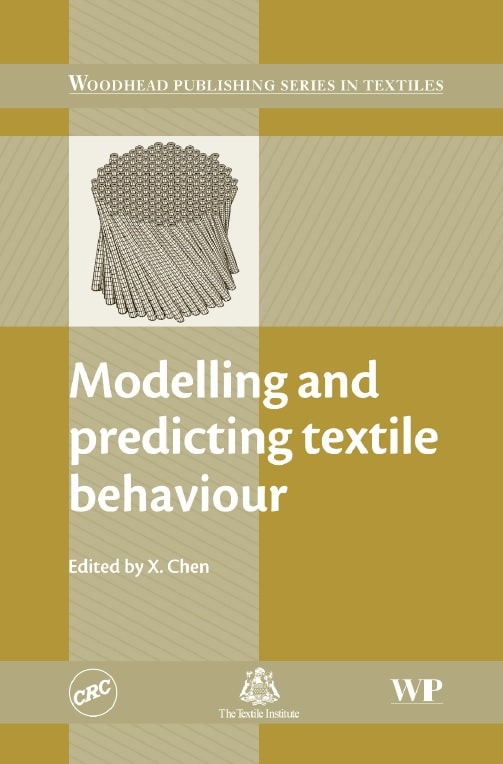
Contents
Contributor contact details xi
Woodhead Publishing Series in Textiles xv
Preface xxi
Part I Modelling the structure and behaviour of textiles
1 Structural hierarchy in textile materials: an overview 3
X. Chen and J. W. S. Hearle, The University of Manchester, UK
1.1 The textile hierarchy 3
1.2 Modelling of fibres from the molecular level 4
1.3 Modelling fibre behaviour 11
1.4 Modelling yarns and cords 14
1.5 Modelling fabrics 18
1.6 Sources of further information 37
1.7 References 37
2 Fundamental modelling of textile fibrous structures 41
S. Grishanov, De Montfort University, UK
2.1 Introduction 41
2.2 Fibre classification 43
2.3 Fibre functions in textile materials and composites 43
2.4 Modelling fibre structure 47
2.5 Statistical models of fibre geometry 52
2.6 Modelling mechanical behaviour of single fibres 68
2.7 Viscoelastic properties of fibres 76
2.8 Modelling fibre friction 86
2.9 Modelling fibre assemblies 89
2.10 Conclusions 102
2.11 References 103
3 Yarn modelling 112
R. Ognjanovic, Innoval Technology Limited, UK
3.1 Introduction 112
3.2 Yarn construction 113
3.3 Types of models to predict the structure and properties of yarns 114
3.4 Applications and examples 136
3.5 Future trends in yarn modelling 138
3.6 Sources of further information and advice 139
3.7 References 140
4 Modelling the structures and properties of woven fabrics 144
E. Vidal-Salle and P. Boisse, INSA Lyon, France
4.1 Introduction: The importance and objectives of modelling woven fabrics 144
4.2 The mechanical behaviour of woven fabrics 145
4.3 Different approaches for modelling the mechanical behaviour of woven fabrics at different scales 148
4.4 Structure and geometry of the unit woven cell 153
4.5 Specific experimental tests 155
4.6 3D simulation of the deformation of the unit woven cell at the mesoscopic level 161
4.7 Image analyses: Full field digital image correlation measurements and X-ray tomography 172
4.8 Conclusions and future trends 174
4.9 References 175
5 Modelling of nonwoven materials 180
N. Mao and S. J. Russell, University of Leeds, UK
5.1 Introduction 180
5.2 Constructing physical models of nonwoven structure 182
5.3 Modelling of pore size and pore size distribution in nonwoven fabrics 185
5.4 Tensile strength 189
5.5 Modelling the bending rigidity of nonwoven fabrics 192
5.6 Modelling the specific permeability of nonwovens 193
5.7 Thermal resistance and thermal conductivity 204
5.8 Acoustic impedance 207
5.9 Particle filtration in nonwoven filters 212
5.10 Future trends and sources of further information and advice 219
5.11 References 220
6 Modelling and visualization of knitted fabrics 225
Y. Kyosev, Niederrhein University of Applied Sciences, Germany, W. Renkens, Renkens Consulting, Germany
6.1 Aim and objectives of modelling knitted structures 225
6.2 Classification of knitted structures 226
6.3 Scales in the structure 228
6.4 Structural elements of knitted structures at the meso-scale 231
6.5 Modelling steps 236
6.6 Model building 237
6.7 Post-processing 256
6.8 Other types of model 257
6.9 Application areas of the simulated fabrics and future trends 257
6.10 Conclusions 258
6.11 References 259
Part II Case studies
7 Modelling of fluid flow and filtration through woven fabrics 265
M. A. Nazarboland, X. Chen and J. W. S. Hearle, University of Manchester, UK, and R. Lydon and M. Moss, Clear Edge Group, UK
7.1 Introduction 265
7.2 Various techniques in modelling fluid flow and filtration 267
7.3 Model design and analysis 271
7.4 Influence of fabric parameters on flow performance 285
7.5 Influence of fluid flow and fabric parameters on filtration performance 299
7.6 Influence of particle properties on filtration performance 306
7.7 Application of fluid flow and filtration modelling 316
7.8 Future trends 317
7.9 References 318
8 Modelling, simulation and control of textile dyeing 322
R. Shamey, North Carolina State University, USA
8.1 Introduction 322
8.2 Sorption isotherms 323
8.3 Dye diffusion models 326
8.4 Models relating dyeing parameters to the quality of dyeing 328
8.5 Numerical simulation of package dyeing 347
8.6 Applications 353
8.7 Future trends 356
8.8 Acknowledgment 356
8.9 References 356
9 Modelling colour properties for textiles 360
D. P. Oulton, The University of Manchester, UK
9.1 Introduction 360
9.2 Types of model used 364
9.3 Case study in colour communication 376
9.4 Future trends in colour modelling 381
9.5 Commercial vendors and their products 384
9.6 References 385
10 3D modelling, simulation and visualisation techniques for drape textiles and garments 388
F. Han and G. K. Stylios, Heriot-Watt University, UK
10.1 Introduction 388
10.2 Review of 3D textile models 389
10.3 Automatic measurement of fabric mechanics 392
10.4 Drape measurement and evaluation 393
10.5 Key principles of 3D mass–spring models 398
10.6 Clothing simulation: strengths, limitations and suggested improvements 403
10.7 Experimental results and discussions 406
10.8 Applications and examples 410
10.9 Conclusions and future trends 418
10.10 References 419
11 Recognition, differentiation and classification of regular repeating patterns in textiles 422
M. A. Hann and B. G. Thomas, University of Leeds, UK
11.1 Introduction 422
11.2 Study of pattern: historical precedents 423
11.3 Symmetry in pattern: fundamental concepts 426
11.4 Classification of motifs 430
11.5 The seven classes of border patterns 432
11.6 The 17 classes of all-over patterns 436
11.7 Colour symmetry 450
11.8 Conclusions 452
11.9 References 453
12 Mathematical and mechanical modelling of 3D cellular textile composites for protection againsttrauma impact 457
X. Chen, The University of Manchester, UK
12.1 Introduction 457
12.2 Mathematical description of cellular textile structures 459
12.3 Computer aided design/computer aided manufacturing (CAD/CAM) of 3D cellular woven fabrics 462
12.4 Experimental study of properties of 3D cellular composites 468
12.5 Theoretical characterisation of 3D cellular composites 476
12.6 Discussions and conclusions 490
12.7 Future trends 492
12.8 References 492
13 Development and application of expert systems in the textile industry 494
R. Shamey, W. S. Shim and J. A. Joines, North Carolina State University, USA
13.1 Introduction 494
13.2 System principles 499
13.3 Strengths and limitations of expert systems 507
13.4 Applications of expert systems in the textile industry 509
13.5 Future trends 514
13.6 Sources of further information and advice 514
13.7 References 514
Index 521
